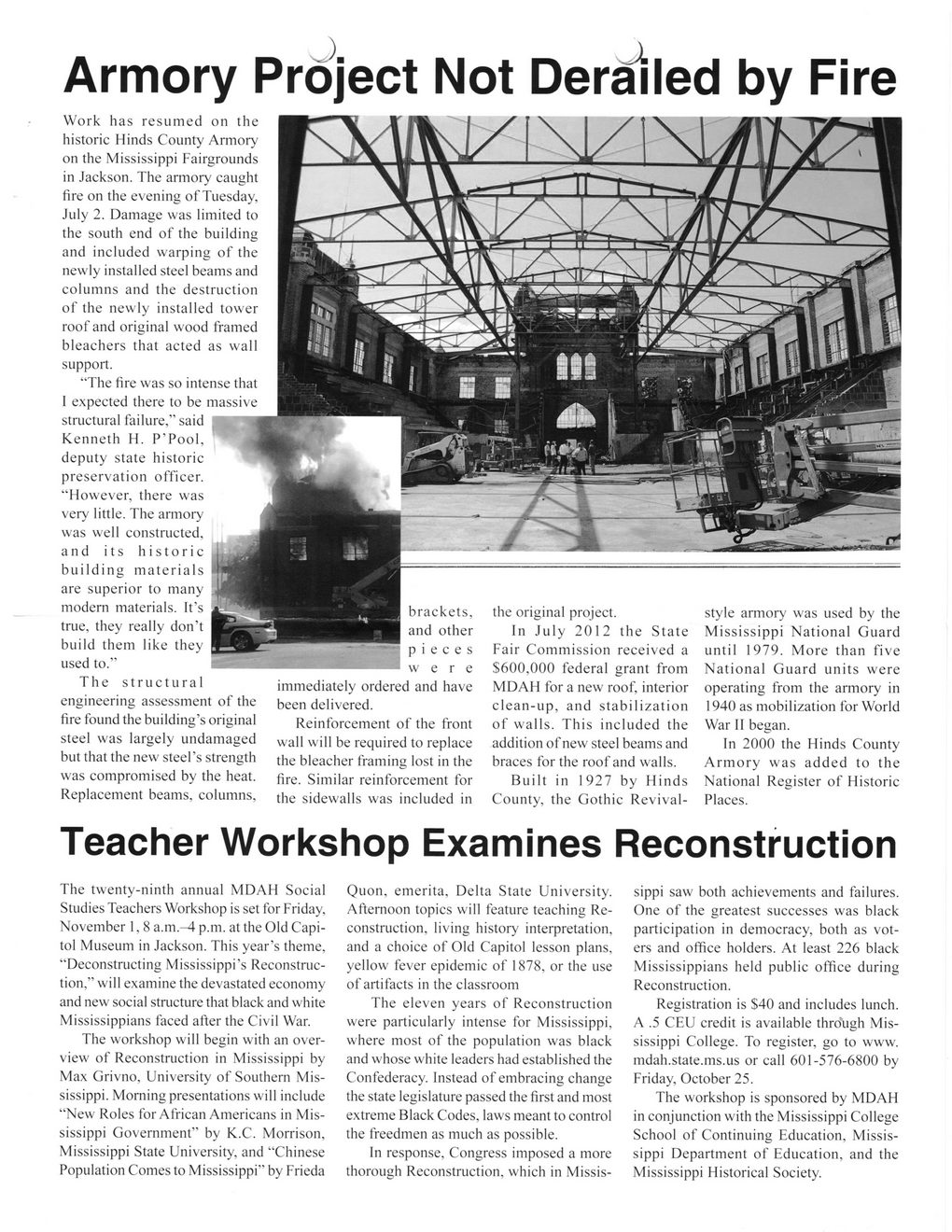This text was obtained via automated optical character recognition.
It has not been edited and may therefore contain several errors.
Armory Project Not Derailed by Fire Work has resumed on the historic Hinds County Armory on the Mississippi Fairgrounds in Jackson. The armory caught fire on the evening of Tuesday, July 2. Damage was limited to the south end of the building and included warping of the newly installed steel beams and columns and the destruction of the newly installed tower roof and original wood framed bleachers that acted as wall support. “The fire was so intense that 1 expected there to be massive structural failure,” said Kenneth H. P’Pool, deputy state historic preservation officer. “However, there was very little. The armory was well constructed, and its historic building materials are superior to many modem materials. It’s true, they really don’t build them like they used to.” The structural engineering assessment of the fire found the building’s original steel was largely undamaged but that the new steel’s strength was compromised by the heat. Replacement beams, columns, brackets, and other pieces were immediately ordered and have been delivered. Reinforcement of the front wall will be required to replace the bleacher framing lost in the fire. Similar reinforcement for the sidewalls was included in the original project. In July 2012 the State Fair Commission received a $600,000 federal grant from MDAH for a new roof, interior clean-up, and stabilization of walls. This included the addition of new steel beams and braces for the roof and walls. Built in 1927 by Hinds County, the Gothic Revival- style armory was used by the Mississippi National Guard until 1979. More than five National Guard units were operating from the armory in 1940 as mobilization for World War II began. In 2000 the Hinds County Armory was added to the National Register of Historic Places. Teacher Workshop Examines Reconstruction The twenty-ninth annual MDAH Social Studies Teachers Workshop is set for Friday, November 1,8 a.m.^I p.m. at the Old Capitol Museum in Jackson. This year’s theme, “Deconstructing Mississippi’s Reconstruction,” will examine the devastated economy and new social structure that black and white Mississippians faced after the Civil War. The workshop will begin with an overview of Reconstruction in Mississippi by Max Grivno, University of Southern Mississippi. Morning presentations will include “New Roles for African Americans in Mississippi Government” by K.C. Morrison, Mississippi State University, and “Chinese Population Comes to Mississippi” by Frieda Quon, emerita. Delta State University. Afternoon topics will feature teaching Reconstruction, living history interpretation, and a choice of Old Capitol lesson plans, yellow fever epidemic of 1878, or the use of artifacts in the classroom The eleven years of Reconstruction were particularly intense for Mississippi, where most of the population was black and whose white leaders had established the Confederacy. Instead of embracing change the state legislature passed the first and most extreme Black Codes, laws meant to control the freedmen as much as possible. In response, Congress imposed a more thorough Reconstruction, which in Missis- sippi saw both achievements and failures. One of the greatest successes was black participation in democracy, both as voters and office holders. At least 226 black Mississippians held public office during Reconstruction. Registration is $40 and includes lunch. A .5 CEU credit is available through Mississippi College. To register, go to www. mdah.state.ms.us or call 601-576-6800 by Friday, October 25. The workshop is sponsored by MDAH in conjunction with the Mississippi College School of Continuing Education, Mississippi Department of Education, and the Mississippi Historical Society.

Mississippi History Newsletter 2013 Fall (7)